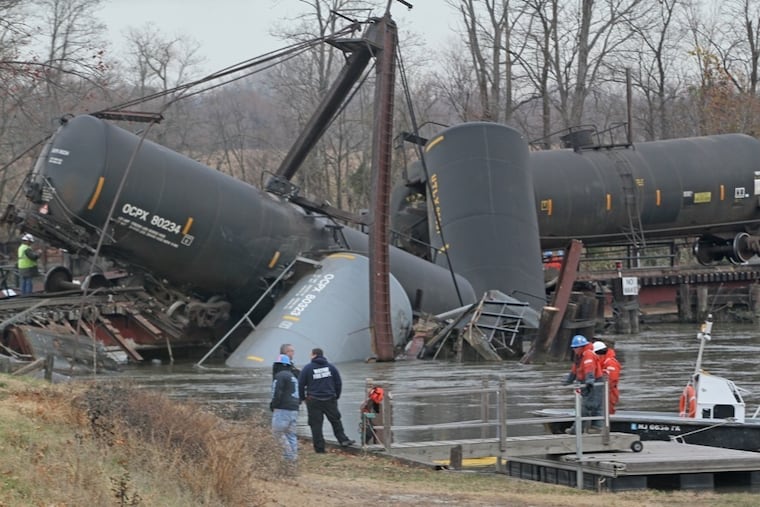Ohio train derailment involves same chemical that was released in the Philly region a decade ago
Ohio's train derailment this weekend echoes a crash in Paulsboro, N.J. more than a decade ago.

A freight train had toppled off the rails and colorless, toxic gas was spreading into the air.
That was the scene when a train derailed Sunday in Ohio, near the Pennsylvania border, and more than a decade ago, when a train toppled in Paulsboro, Gloucester County. In both incidents, the gas form of vinyl chloride, a chemical used to make plastics, adhesives, and other chemicals, leaked into the environment.
The Ohio train derailment occurred in East Palestine, about an hour northwest of Pittsburgh, when a railcar axle failed. Ten of the cars involved carried hazardous chemicals, including five that held vinyl chloride. Everyone within a mile of the crash was ordered to evacuate Sunday.
By Tuesday, crews were slowly releasing the gas from the cars and igniting it, the Associated Press reported, to destroy the chemical before it spread. Burning it, though, releases phosgene and hydrogen chloride, which are also toxic.
Pennsylvania Gov. Josh Shapiro recommended anyone within a 2-mile (3.2-kilometer) radius of the crash site shelter in place and keep doors and windows closed into the evening.
Vinyl chloride has a mild, sweet odor, the Centers for Disease Control and Prevention reported, and at low levels can cause dizziness and sleepiness. At higher levels, it can cause people to pass out and eventually die. Longer exposure to the chemical, as might be experienced by people who work with it, is associated with liver cancer, and possibly brain, lung, and some kinds of blood cancers. The chemical burns easily and is unstable at high temperatures.
A decade earlier, a similar incident in New Jersey prompted freight rail companies to adopt federal guidelines for accidents involving dangerous chemicals. Prior to that, railroad protocols differed from federal recommendations, causing confusion.
The Paulsboro incident happened when a swing bridge over Mantua Creek failed on Nov. 20, 2012, derailing seven cars and toppling four into the creek. One ruptured, releasing 23,000 gallons of vinyl chloride that wafted into the town.
About 700 residents evacuated from their homes at the time, and thousands of Paulsboro residents sued Conrail, the bridge’s owner and operator, over the aftereffects of exposure to the gas. They reported symptoms including headaches, respiratory problems, and dizziness.